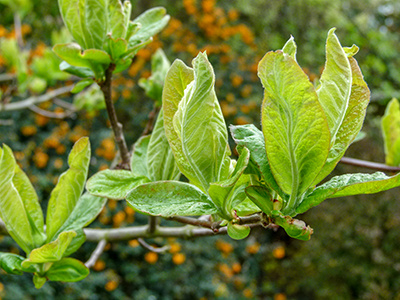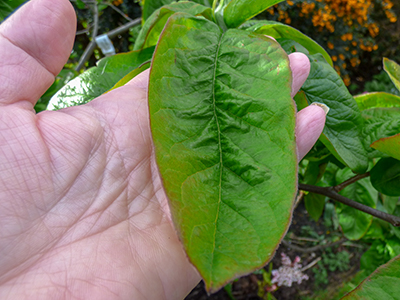

Home
About Us
Allotments
Garden Equipment
Seed Suppliers
Manure Problems
Children's Pages
GLA Blog
Weather Blog
School Veg Patch
Useful Links
Growing Medlars
In 2006 we decided to plant a medlar tree in the garden. The main reason for planting it was for ornamental value. All the information said that it had large glossy leaves, attractive white flowers, good autumn colour and unusual shaped fruits so it sounded like a good choice. I read somewhere that it grows to 20’ in height but some judicious pruning can keep it to a more modest proportion.
The first year the tree remained in a pot and only produced one flower. It was then planted into the garden where it produced five flowers. Apparently, due to the flowers appearing after most late frosts, it is usual for every flower to develop into a fruit and this was certainly true as we had five fruits. The flowers are self fertile and it also apparently can develop fruits even if the flower isn’t pollinated – how does that work then? The medlar is related to the rose and the flowers do show some resemblance.

 The leaves of the medlar are large and ruffled and so are prone to being damaged in strong winds.
The leaves of the medlar are large and ruffled and so are prone to being damaged in strong winds.
The new growth appears on the ends of the branches and is a bright fresh green.

The leaves darken as they age and become more ruffled. There is also a faint reddish tinge to the edges of the leaves.

In autumn the leaves become a vibrant yellow.

The fruits are a curious shape resembling really large rose hips. They are given a rather unflattering nickname in French is cul de chien which to put it politely describes it as a dog's bottom.
They are a yellowish brown colour a bit like a russet apple.

We weren't really at all sure what to expect from the fruits. Once taken from the tree the fruits have to be allowed to ‘blet’ which apparently means that they must be left to decay and go soft. During this process sugars are supposedly produced and acidity diminishes. Also the fruit softens. Having picked our first five fruits we placed them in a cool room calyx end down until they ‘bletted’. This is supposed to take between two weeks to a month. The fruit can then be eaten raw or cooked. The taste is said to be reminiscent of caramel but I thought it just tasted like an over-ripe apple.

One slight problem is that if you happen to pick our medlars too soon they will just shrivel and dry up.
Medlars date back to the middle ages when they were very popular. I wondered why they lost favour but having tasted I can hazard a guess.

In it's second year the tree produced a few more fruits, so we decided to try and make some medlar jelly.
The medlar jelly tasted OK but it was a lot of effort to go to in order to produce and we don't really eat jellies or jams.
We haven't really used the fruits since and are content to grow it as an ornamental plant.
Medlars have featured in several of my blog post as I followed the tree month by month.
If you are interested follow the links below.
Our Plot at Green Lane Allotments Blog | A Gardener's Weather Diary | School Vegetable Patch Website
© Our Plot on Green Lane Allotments - Please email me if you wish to use any of this site's content